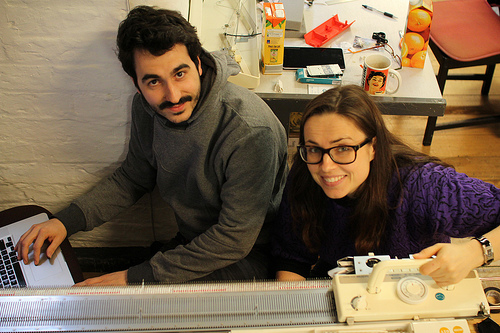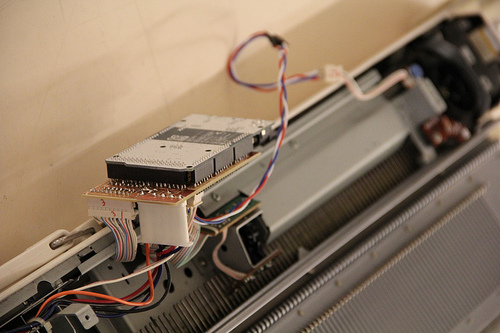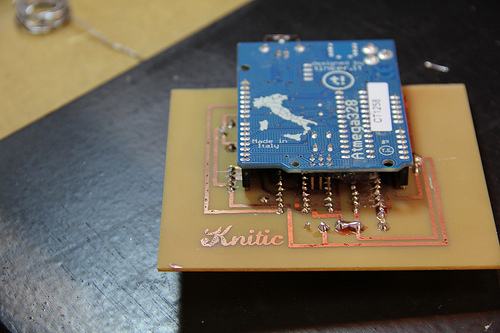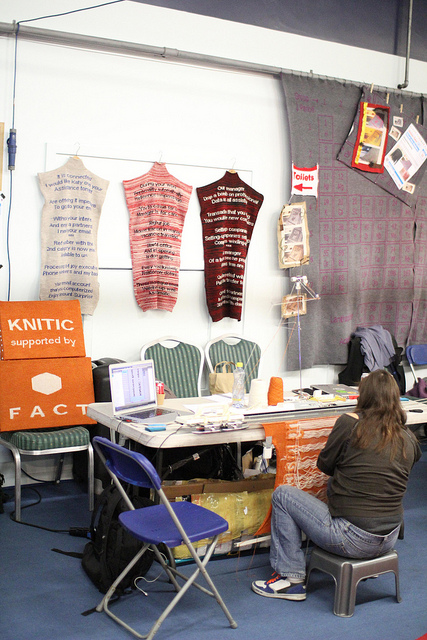Knitic project, or how to give a new brain to knitting machines

Knitic is an open source project which controls electronic knitting machines via Arduino. To be more precise, Knitic is like a new ‘brain’ for the Brother knitting machines allowing people to create any pattern and modify them on the fly. Knitic kit is composed by an Arduino Due, a diy printed circuit board on top of it, connected to the electronic parts of the original machine, (like end-of-line sensors, encoder, and 16 solenoids) and a software to control the needles real-time.

In the past days I interviewed Varvara & Mar, the duo who developed the project. They’ve been working together as artists since 2009 and their artistic practices lay at the intersection between art, technology, and science. When I run into their project I immediately liked their approach as they see knitting machines as the first real domestic fabrication tool, that has been overlooked in the age of digital fabrication.
Check the tutorial above and then below some answers to the questions I sent them.
How come you got interested in knitting?
Everything started in January 2012. We had an idea to knit poetry from spam emails. Hence, we were invited to the 3-month-long residency at MU gallery in Eindhoven and 1-month residency with solo exhibition at STPLN in Malmö, to develop our project. After seeing MAKE magazine article on hacked knitting machine by Becky Stern, we thought it’s easy and fun to do the hack. Well, we had a bit underestimated the complexity of the project, but finally made more than one knitting machines work and started also Knitic project.
How and why did Arduino become useful to your project?
Arduino is A and B in our work. It means we use Arduino for many purposes, and to be honest, we don’t imagine our lives without it.
We applied Arduino already in our first hack of knitting machines, when floppy emulation script didn’t work for us, since we had 940 and not the 930 machine. Hence, we connected all buttons of knitting machine keypad to Arduino and were able to program knitting machine automatically.
In terms of Knitic, Arduino has a key role, because it gets the outputs of sensors, energize the right solenoids according to the pattern, and communicates with Knitic program written in Processing.

Some weeks ago you were at Maker Faire in Newcastle : which type of people got interested mostly about Knitic?
Interestingly, the most interested group of people were Dutch educators and the ones connected to creative industries. Also people from local hacklabs were very interested.
In some of your presentations you said that knitting and some other more crafty practices are a bit overlooked by fablabs and makerspaces, why do you think is it like that? Is it a matter of gender balance or there’s something more?
We think it is mainly because of the gender and also because MIT, where the concept of fablab comes from, is dominated by engineers and architects, who saw more potential in hard-surfaced object fabrication, like 3d printing, laser cutting, CNC, etc. Plus there is not much information about hacking and developing open source knitting or sewing machine online. But we hope that things are slowly changing and soon lots of makerspaces will have knitting machines and other tools for handcraft. Hence, we think Knitic is an important example for re-empowering crafts with novel digital fabrication approaches.

I have a knitting machine at home and I realized you need a lot of patience to make it work, but then it’s fun. Do you think that these hacks could lower the barriers and make it more attractive to less nerdish types?
We don’t think that knitting requires more patience than 3D printing, for example. To be honest, with knitting one is able to achieve first results much faster than with a 3D printing machine. To learn a new skill always requires some time investment.
In your opinion, what type of micro-business connected to these knitting machines could flourish in the next years?
Good question. Definitely, custom made knitwear. At the moment, there are no services which are offering knitwear (sweater, scarf, etc) with your own pattern and letting you chose the yarn type. There could be also lots of interactive knitting and unique pattern generations. For example, we are working on a project called NeuroKnitting right now.
Soon we’ll make more information available on it. In addition to that, there is another business option that is open hardware in the form of Knitic Kit (pcb and components) or, why not, the whole knitting machine.
Thank you!